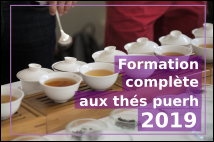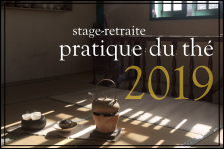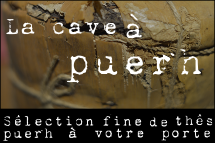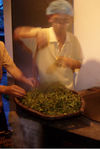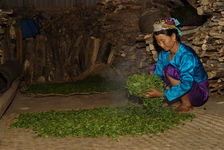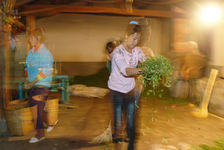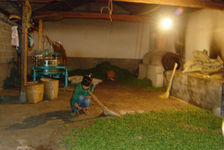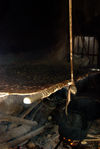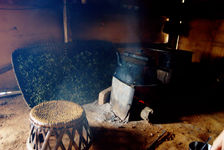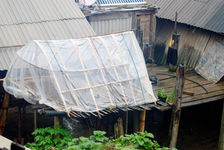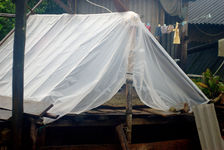 This page is not a real translation but just an automatic translation generated by computer of the original article, written in French language! Its not good... but better than nothing!
This page is not a real translation but just an automatic translation generated by computer of the original article, written in French language! Its not good... but better than nothing!Want to help us do diffuse puerh tea culture in english, by providing a better (or corrected) translation?
Please contact us!

Those who read my articles several years will be the impression of having already received an item with the same title. Indeed, I have decided to revise and enrich greatly a former article published there's almost two years, seen the future site www.puerh.fr, and I'm happy waiting to share with you this new version, much more complete and illustrated that the initial version. Happy reading!
Like for example, white tea which is simply dry the leaves, the tea is said puerh (Pu Er tea) worked, which undergoes a number of treatments once the harvested leaves. This is another of this work between specific leaf puerh (Pu Er tea) that derive their flavor character unique but also their ability to evolve and transform over time. Sun drying is particularly become for many, with the nature of trees growing in Yunnan (so-called large-leaf), the character-defining puerh (Pu Er tea) and often attributed to this "sun drying" the possible aging puerh. It is actually very simplistic and it is from all actions committed, treatments and of changes occurring in the tree to the wafer, the puerh (Pu Er tea) derives its character and its properties so special.
The aim of this paper is to briefly outline the steps used to manufacture a puerh, since picking up the cake leaves, young or old, as briefly addressing issues of fermentation and storage. If these steps are the basis for the preparation of puerh, there are many variations and specificities according to each region, local customs, ethnic groups that live there but also the personal practices of each producer. Besides the great influence of the soil is also this diversity of expertise that comes from the enormous richness and variety of different puerh (Pu Er tea) that can be found on the market.




- 1. Different stages of transformation of the tree to the wafer
- 2. Young woman in SOMET cueuillant leaves a large old tree in Pu'er tea
- 3. Reaping the working sheets day Bulang
- 4. Young woman inusant a cup of puerh
At first glance it may seem unnecessary for the Western Amateur to know the existence and position of each of these steps. Tea is in your cup, however, comes a succession of movements, and those you make to brew your cup of tea are only the latest of this long process in which you participate. Aware of the experiences of the sheet as a whole, or better where possible to experience it by yourself, is thus not something trivial and contributes to the understanding not only intellectual but also sensitive tea. Lu Yu since there are over 1000 years the experts, specialists and advanced amateurs tea parties are in the mountains and have practiced well each of these gestures, picking at the infusion. What one considers "the art of tea" in China does not sums up the gung fu or the art of brewing tea leaves, as is sometimes assumed, but begins with the planting trees and picking leaves and includes all processes that will escort them to the cup. Beyond the understanding of these processes, and origin of different teas which result from the practice of these actions or at least their knowledge also adds a dimension that is sensitive to accompany the tasting and caress the spirit of the drinker while liquor seized his palace. Tea which we lived the story will never have the same flavor that tea about which we know nothing.
puerh (Pu Er tea) work sheets
Once the sheet separated from the tree that gave it birth begins an unbroken succession of steps each of which has an influence on the character of the future tea. Depending on how these steps are not only lead to puerh (Pu Er tea) of different nature (see diagram above), but also within a given type of puerh (Pu Er tea) we note great differences of character in the manner and the care with which this work sheets will be made.
Leaves are usually worked by the harvesters, daily, after the collection day. In some villages such as Wu Yi, then they will be pressed on the farm by the same growers, usually on command. In most cases small growers do not, however, urge their cakes and just sell the raw product worked (mao cha) to producers who will take charge of the press or squeeze them. Sometimes the leaves are not worked on the farm, but in community workshops or cooperatives.



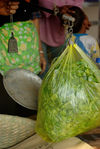
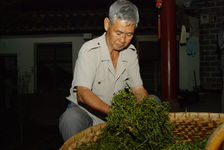
- 1. Different situations and stages of distribution of work between grower and producer
- 2. Small family producer (Wang Bing) Wu Yi in picking tea leaves
- 3. Fresh leaves barely picked at a small producer in Pu'er
- 4. Sales of fresh leaves in a small producer in Pu'er
- 5. Rolling sheets at home on a farm in YiWu
Sometimes it is the fresh leaves, just picked that are sold by harvesters. Much rarer, it allows the producer who buys a quality control and greater stability of its product, but it implies that he has against the capacity to work daily in the leaves the day after a very short time their harvest. Given the sometimes very large distances between the land and accessibility problems of the latter, this requires either hours round trip daily to go collect the fresh leaves or the plant by the producer of the studio to work leaves at the heart of villages like Shuangjiang Mengku Tea Company to Shuangjiang or more recently built by Chen Sheng Banzhang in 2010.
Finally the work sheets do not stop at the walls of the farm and workshop. The tea is puerh (Pu Er tea) living that continues to evolve once compressed, and storage rooms humid Hong Kong or Canton, stocks of Taiwan or Malaysia through the shelves of the Western Amateur, a number of puerh (Pu Er tea) continue to model themselves after their compression in the hands of those who care.
Manual Labor against mechanical work
Besides the traditional handicraft practiced for hundreds of years, summers have developed various machines since the 50s and are used to perform whole or in part, the work of the leaves. According to the growers and producers, work sheets is entirely made "old" traditional way, or with the use of such machines. The question of the use of power tools in the work of the leaves is complex, can not be generalized and should be studied in detail. If it is not just about pure conservatism and aesthetic appeal of a handmade product, we observe that in a number of cases mechanized tool can be a relevant choice.
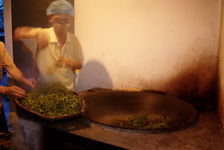
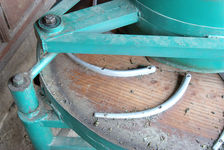
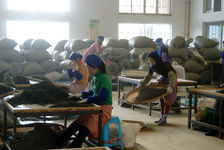
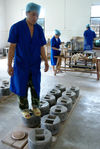
- 1. Sha qing Wu Yi to craft
- 2. Machine Rou Cha Yong From old to
- 3. Chen Sheng Menghai Factory
- 4. Workshop at Baopuxuan YiWu
Some steps in the transformation of leaves, as the Cha Cha Jing or Rou, including asking a great control, a real skill and rigor in order to obtain not only a quality product, but also stability in the production . The work sheets, daily for many months, often occurs at night, after a long day of picking leaves and a number of growers not enough qualified or available, use the machine to attend some sensible steps can sometimes allow for more stable production and increased their overall quality.
While advanced by some producers and sellers as a sign of quality or argument to justify a high price, the craftsmanship should under no circumstances be regarded as a guarantee of quality. Totally handcrafted work is primarily up to give more responsibility to the producer and to engage in skills. If this one excels in the art work sheets, it will result in a product lives up to this control. In contrast, manual work of lesser quality will result in a lower quality tea, then a partially or fully mechanized work will often be at least able to correct and efficient machines and used appropriately be excellent.
1.Cueillette sheets
Puerh leaves are harvested, either old or planted trees in the manner of former and perhaps up to several meters or on plantations artificially maintained at the state and shrubs commonly found on crops in terraces (Tai Di).

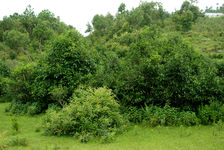
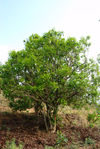
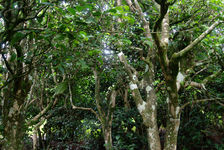
- 1. Landscape of Tai Di in loss of horizon Dadugang
- 2. Great tea trees in Yong In, Lincang
- 3. Old tea tree to Bing Dao, Lincang
- 4. Trees in old Nanuo, Xishuangbanna
Among other things, because these are the leaves that are picked, not the fruit, the harvest takes place continuously from spring to fall, not like other crops annually. The leaves, collected daily and hand-cut and are selected so that new leaves can push in their place. The climate is mild Yunnan, tea trees are harvested during a great period of the year in some regions may extend to 10 consecutive months, covering the fall, spring and summer.
Of these three seasons, is generally considered as the upper spring tea. The cakes are puerh (Pu Er tea) and as appropriate, from tea to a particular season, eg spring or autumn, and sometimes a given period of the season (early spring crops, for example), or are the result of assembly which can take place in leaves of different seasons, to enrich the character and balance of the tea, or to lower its price of production.
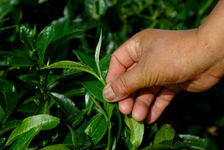
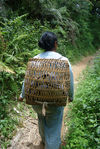
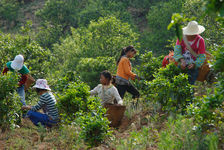
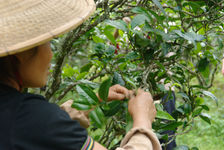
- 1. bud and young leaf puerh (Pu Er tea) (Jinuo Shan)
- 2. Young woman on the way of tea (Wu Yi)
- 3. Young women collecting an ecological garden (Bing Dao)
- 4. Young Women collecting an ecological garden (Bing Dao)
You reap all the young shoots, called buds, as well as the first two or three sheets, defined by their age. In the most rudimentary cases (current) one does not care about the number of leaves but only leaves remaining on the tree in order to allow it sufficient energy to produce new shoots. When the collection is more pointed one chooses the cut only the two or three youngest leaves, sometimes even we restrict to the bud or the contrary we will add some leaves to their former special flavors. Other leaves, young and old, for their part remain on the tree to provide the energy necessary for its growth. The choice of what will be picked and the precision of the harvest is a very important factor. Grabbing a tea garden green (planted in a natural way like the former), is not plucked the trees found there, but flitting from tree to tree for each pick a few handfuls of leaves only. It is therefore essential to have the eye and to choose among the thousands of leaves of the tree, those to be cut. This will not only have a decisive influence on the flavor and character of future tea, but also on the leaves to come, which will replace those removed as well and more generally on growth and flowering of the tree. A harvest too "greedy" or too regular affaibliera including the tree and the quality of tea it will produce.
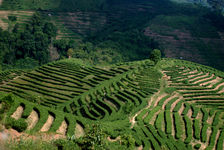
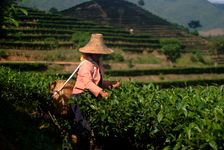
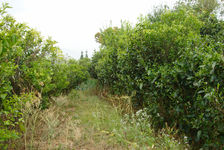
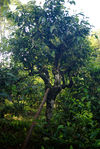
- 1. Culture in Tai Di facilitate harvesting (Jinuo Shan)
- 2. Harvest Di Tai (Shan Jinuo)
- 3. Alleys of medium-sized trees
- 4. bamboo rod placed on a ancient tree to reach the summit
The harvest also depends largely on the nature of trees. In the case of Tai Su, terraced fields kept at hand, it can be likened to the harvest of other teas like oolong or green tea, and just browse the aisles of tea plants to harvest the leaves , by hand or with tools. The collection of ancient trees and wild trees, often several meters in height requires more effort. A number of these old trees tens to hundreds of years are at eye level, and need to stand on tiptoe to reach the highest leaves.
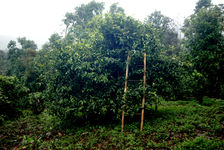
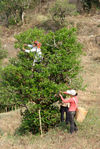
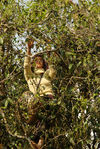
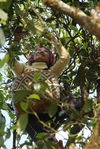
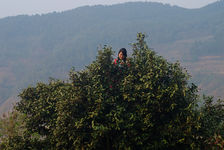
- 1. Scale placed on an old tree to climb more easily (Banzhang)
- 2. leaf pickers in environments with large trees to Bing Dao Mengku
- 3. leaf pickers in environments with large trees Bing Dao Mengku
- 4. leaf pickers in environments with large trees to Bing Dao Mengku
- 5. Girl on top of a tall tree in Pu'er
Many mature trees reach several meters per cons. For the smallest of them, it needs to help a scale or just a big bamboo pole resting on their trunk to reach their peak, while that for older children it is truly necessary to mount in the tree, sometimes 10 meters to pick the leaves. This is also true of the real wild trees, rare, found in forests and are generally collected by the inhabitants of the mountain, although this practice, now banned or restricted.
2.Fétrissage, ventilation
Once the leaves collected, they are faster out of bamboo basket or canvas bag pick-up and spread. And they will dry in air, typically about a few hours, sometimes in the sun (first sun drying) if the weather permits, or if in an interior, fresh or heated. The purpose of this step is to reduce the moisture content of fresh leaves, to relax them and sometimes reduce their temperature. Note in fact that this drying conditions can vary widely among small producers, according to the habits of each family, and the conditions météologiques, the true sun drying, drying under glass, by the fire in a shed wood, etc. ...
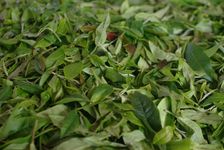
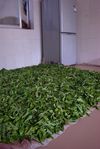
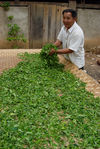
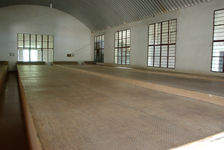
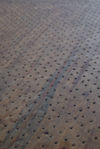
- 1. Leaves freshly harvested
- 2. Fresh leaves drying in the kitchen (Wu Yi)
- 3. Fresh leaves spread out to a first sun drying (Mengku)
- 4. Industrial Drying leaves (Shan Jinuo Chang Cha)
- 5. Industrial Drying sheets (Jinuo Shan Chang Cha)
When the tea is processed industrially in large workshops, this drying is usually done mechanically. The leaves spread out on large tables will be punched through which a current of air, ideally fresh product with large fans.
3.Sha Qing
The "Sha Qinq" is an absolutely crucial step in the work sheets puerh. Literally "kill green", it is sometimes translated into French by roasting. While the principle and the tools used may well be thinking of roasting, the issue of Sha Qing, and its development are quite different. It is indeed not a sculpt by pushing the roasting aroma of tea but simply to evacuate by a rapid shift to high temperature most of the water in the leaves, and destroying enzyme activity , to prevent the various transformations that cause fermentation of the tea.
Craftsmen, and the leaves are thrown into a large wok heated over a wood fire where they are perpetually set in motion for a few minutes directly with bare hands or with sticks of wood or bamboo. Fire temperatures and stability are crucial for the quality of tea. The movement of leaves in the wok is very important and must allow proper drainage of water vapor and prevent the leaves burn out or burn on contact with hot metal. The leaves are removed when they touch does not cause a sensation slightly sticky, not too cold or too dry.
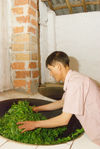
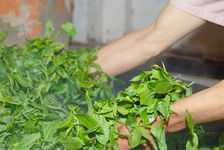
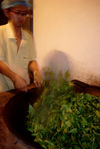
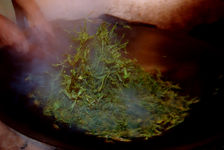
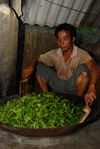
- 1. Sha Qing craft bare hands to Bing Dao Mengku, Lincang
- 3. Sha Qing artisanal YiWu, Xishuangbanna
- 5. Sha Qing Shan artisanal Bulang, Xishuangbanna
Although in some areas the majority of producers are still working craftsmen, the Sha Qing is often made here and there with a machine. Sha Qing machines consist of a heated metal cylinder and striated that by turning the sheets is in motion. It shoves one end which leaves out the other after having been partially dried. Facing the Qing Cha manual, the use of a workhorse and well regulated not only allows finer control of the temperature but also by limiting the human factor greater stability of production. Proponents of Sha Qing craft reproach against the machine by a lower extraction of water from the leaves and the loss of a certain charm of craftsmanship.
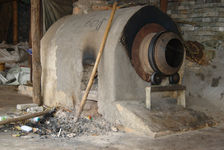
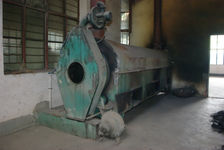
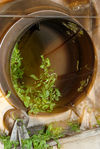
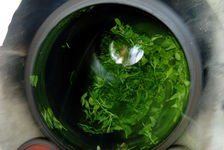
- 1. Old machine Sha Qing Mengku
- 2. Sha Qing machine in the factory Jinuo Cha Shan Chang
- 3. Sha Qing machine running
- 4. Sha Qing machine in operation
Another time it should be noted, beyond the technical considerations of these two approaches, the decisive role of the producer. The producer qualified and conscientious, able not only to fully control temperature of the fire and movement of leaves in the wok, but also to do this work daily with the same precision, will be able to take advantage of craftsmanship, while a craftsman not qualified enough or just looking for quality, sha qing get a better bill and more homogeneous with a machine.
4.Aérer tea
A step often overlooked in the descriptions but which is important, it is the aeration and cooling of the leaves along the Sha Qing. The leaves are transferred, ventilated, and scattered, generally on a woven bamboo surface to dissipate the heat they contain and prevent the latter negatively affects the next step.
5.Rou Cha
The Rou Cha that can be translated into French as "kneading" or "rolling" is a very crucial step in the production of which depends greatly puerh (Pu Er tea) and the character of the tea that will result. This is, as its name implies to roll and knead briefly leaves, so slightly damaging the surface, allow a better extraction of flavors they contain but also to sculpt giving them their final form , elongated and twisted. Besides the aesthetic issue this form will also influence the subsequent processing of the sheet.
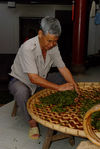
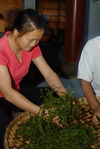
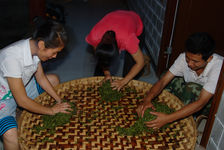
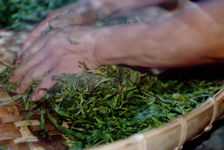
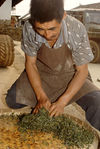
- 1. Kneading craft sheets puerh (Pu Er tea) a farm of Wu Yi
- 3. Kneading craft sheets puerh (Pu Er tea) a farm in Wu Yi
- 4. Kneading craft sheets puerh (Pu Er tea) a farm of Wu Yi
- 5. Kneading craft sheets puerh (Pu Er tea) in Pu'er
Traditionally the leaves are rolled into a ball as well, by hand, over a range of woven bamboo. The kneading is performed several times between which the leaves are thrown into the air to separate them and air them before rolling again. The accuracy of this practice and its careful application is crucial in making tea. The pressure applied during the mixing process must in particular be fully measured. Too much pressure do not allow such a good subsequent extraction of flavor, or worse spoil the integrity of the leaves. The Rou Cha is complete when the leaves have taken their twisted appearance while is a strong characteristic odor and is felt as the leaves begin to ooze and deviennir sticky.
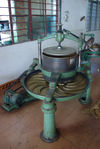
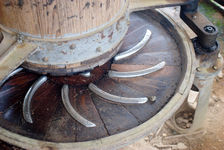
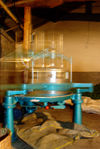
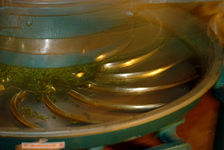
- 1. Machine mechanics Rou Cha (Cha Shan Chang Jinuo)
- 2. Old machine Rou Cha wooden Lao Banzhang, Bulang
- 3. Rou Cha machine operating at BingDao, Mengku
Also used since the 30 machines to do the Rou Cha, particularly in the area Menghai. The machine consists of a vertical cylinder in which the leaves are slightly compressed and then thrown from a rotating disk on which are the kinds of blades that will "knead" tea. I happened to see in some villages, very old manual models, but I doubt they are still used, the followers of Rou Cha mechanical being long past the motor. It seems difficult when observing this type of machine function, to achieve the quality and control of a manual kneading, which usually confirms when one tastes the same tea hand rolled or machine ...
6.Séchage/cuisson sheets ("sun")
Once kneaded, the leaves are dried in air for a period ranging from hours to several days, according to the methods employed and the weather (in the case of drying a "natural"). Although we usually speak of drying it is not simply dehydrate the leaves as might be suggested, but a real transformation of the leaf, which some prefer to say that the leaves "cook" the sun. While in touch they pass the soft and slightly sticky to dry and brittle, their color changes from bright green of fresh leaves in dark green, almost black in some cases.
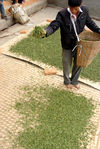
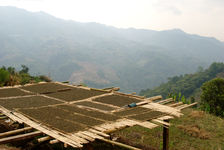

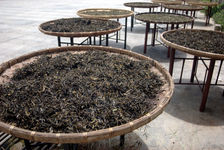
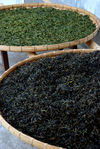
- 1. Last of the leaves to dry Bing Dao Mengku
- 2. Drying the leaves in the sun to Bing Dao Mengku
- 3. Drying the leaves in the sun YiWu
- 4. Drying the leaves in the sun to YiWu
- 5. Leaves in the beginning (green) and end (black) drying YiWu
Traditionally they are spread on large trays or bamboo braids rectangular, then left to air time that the leaves dry, rooftop where in the course if time allows, indoors otherwise. This is where may lie a major cause of non-uniformity within a production puerh (Pu Er tea) and that not only the raw material can be very different from one region to another, from one village to another but also from one season to see the other one week to another!
Indeed, we speak often of "sun drying", making it one of the key steps that puerh (Pu Er tea) derives its flavor and its properties. However, this is in fact more of an air-drying as a real sun-drying. Whoever is in fact already made in the Xishangbanna, especially during the rainy season (during which we continue to harvest the tea), will find it just as you can sometimes wait long before seeing the slightest ray of sunshine and the puerh (Pu Er tea) there often dry "rain"). The time and drying conditions are very variable depending on whether it takes place outdoors in good weather when the leaves literally cook in the sun for less than a day, or indoors where the leaves often are stuck in a long day atmosphere to exceed ninety percent humidity. The smell of wet leaves in the night before drying, or during it if done in a humid atmosphere, then something particularly intense and mesmerizing.
Despite having suffered a previous Sha Qin, wet leaves continue to undergo many changes during this drying time, and what differentiates them clearly from other types of tea for which drying is intended to "fix" and somehow stabilize the heritage of the sheet. It is also a time, sooner or later, when many external factors may influence or interfere tea, weather as we have seen, but any human intervention. If indeed some indoor drying means drying in a greenhouse in semi-outdoor, in many villages this means a leaf drying "at home" amidst the smoke of wood fires and smells of food cooked therein. When you see the incredible ability of a cake of dry puerh (Pu Er tea) to absorb surrounding odors, one can easily imagine what it is wet leaves freshly kneaded ...
It reminds me a week in the rainy season, in the traditional wooden house of a small producer of Lao Ban Zhang. The rain had fallen relentlessly all week, the dried tea leaves were spread as close as the only heat source, ie all against fire. They have thus bathed continuously throughout the week in the thick smoke from the fireplace (which was burned and even occasionally a small log eucalyptus!). Although it is absolutely not done consciously to give a flavor to tea, and, according to the producer, it has no consequences, the influence of this "smoking" leaves on the aroma of tea is no and can probably be attributed to some very light smoky taste that emerge sometimes some puerh.
The irregularity of drying and its seasonal variations are also arguments that justify for supporters of the assembly, the use of leaf blending in order to "standardize" the taste of all the wafers of a given production see to perpetuate this taste from year to year.
Drying can also be performed industrially by the leaves stay in a ventilated atmosphere (wind) warm and dry. Industrial drying is of course more regular and undoubtedly provides a more uniform result ... may be at the expense of a certain charm and character of puerh, which is well appreciated than random. I also happened to see in some region of drying cabinets in small growers and craft workshops, used when the climate does not allow outdoor drying.
7.Tri yellow leaves (Gian Huang Pian)
Once the leaves dry, they are sorted first time, one by one, to extract and separate the leaves of lower quality. This is the case of yellow leaves (Huang Pian), regarded as inferior, and present in significant quantity in the mao cha crude, ill-shaped leaves at the roullage, leaves damaged by labor, branches and other unwanted element but also leaves with the absence of aspects. More sorting is, the more will the tea, and a kilogram of Maocha be expensive.
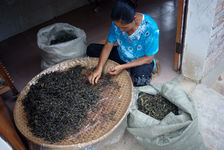
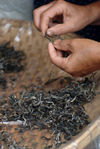
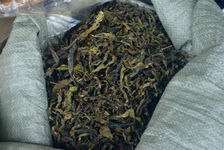
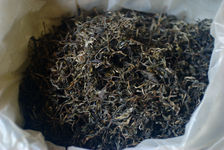
- 1. Sorting in YiWu Yellow leaves (Wang)
- 3. Yellow leaves removed during sorting (Wang Bing, YiWu)
- 4. Mao Cha sorted (Wang Bing, YiWu)
The amount of yellow leaves in the Maocha is especially considered a quality criterion and has a strong influence on the price of this Maocha. Yellow leaves removed during sorting are often used to take place in low quality teas (but can sometimes still be very interesting to the palate), and sometimes only to press cakes made of yellow leaves, like the 07,304 produced by Baopuxian, whose flavors are usually very specific soft keys marked by fresh can remember camphor or eucalyptus.
Although objectively inferior to the standards of puerh, these yellow leaves, or other lesser extent leaves and debris extracted during the sorting can have taste properties quite interesting and in some cases are deliberately retained or added during assembly to sculpt the character of the tea.
8.Entreposage
In the state, the puerh (Pu Er tea) product is called Mao Cha and can be consumed. It is in this form (and uncompressed) that is consumed by much of the local producers puerh (Pu Er tea) in rural areas and production. Many growers do not press patties and it is in these cases the form of mao cha that tea is sold by the kilogram to others who will press.
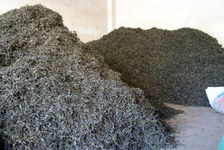
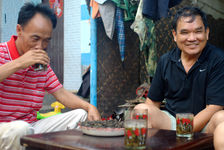
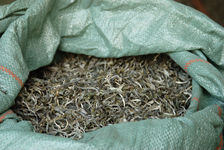
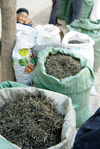
- 1. Pile of Mao Cha Mengku, Lincang
- 2. Infusion of Mao Cha in glasses of water in the villages producers (Jinuo Shan, Xishuangbanna)
- 3. Mao Cha in bags ready to be sold (Mengku, Lincang)
- 4. Bag Cha Mao sold on the market (Lincang)
The Maocha is often pressed into the weeks or months after the harvest, but it can take time, sometimes long between the time the mao cha is produced and sold and when it is pressed. Providing greater surface contact with air, the leaves will turn more quickly and substantially different in this form once compressed. This time storage compression and pre-conditions of storage such as humidity, temperature, materials in which the Maocha is stored, and any surrounding odors sometimes have a strong impact on the history and taste of future cake.
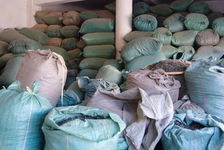
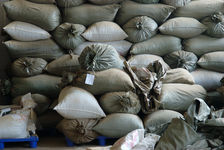
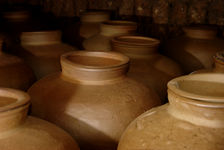
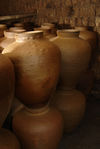
- 1. Stock of Mao Cha
- 3. Large ceramic jars for the storage end of Mao Cha (Lincang)
- 4. Large ceramic jars for the storage end of the Mao Cha (Lincang)
Involuntary and often dependent on the market, this storage before compression is sometimes done intentionally for his influence on the result. Some growers store and pointed their Maocha a certain time, sometimes years, before squeezing into patties, to take advantage of the changes that take place during this period.
9.Fermentation ( some puerh (Pu Er tea) only )
A number of puerh, called Shu Cha, puerh (Pu Er tea) fermented puerh (Pu Er tea) cooked or fermented black are puerh (Pu Er tea) artificially before being pressed. Fermentation or puerh (Pu Er tea) Wo Dui (渥 堆) is a specific technical and complex, developed in the 70 to simulate the aging of puerh. Kept secret for some time by the state factories, creating the legend of the secret of puerh (Pu Er tea) fermentation, fermentation techniques puerh (Pu Er tea) the public and are now a number of small factories and workshops producing puerh (Pu Er tea) fermented with results and hygiene reasons vary according to the producers.
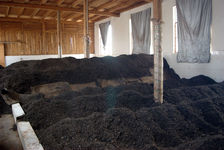
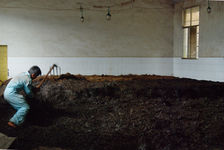
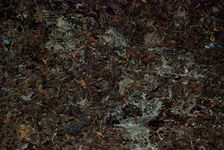
- 1. Fermentation of puerh (Pu Er tea) (stack puerh) in Pu'er
- 2. Fermentation of puerh (Pu Er tea) (vent stack) to Lincang
- 3. Fermentation of puerh (Pu Er tea) (retail mold) to Lincang
The fermentation of artificial puerh (Pu Er tea) involves various stages, each having great importance for the quality of the result and I will not detail the scope of this article. The focus of the fermentation of puerh (Pu Er tea) is to train with lots of leaves puerh (Pu Er tea) drawn according to their size, which will then be moistened and covered a time of tight sheeting so that the phenomenon of fermentation occurs. As the heat rises naturally at the heart of the heap, many changes take place at the leaf surface, their color gradually changes from green to brown, while the flavors mellow, round off to approach older teas.
If this technique was originally developed to approach the flavors puerh (Pu Er tea) old issues have largely evolved since the 70s. The fermented puerh (Pu Er tea) is now a class full of tea and fermentation of the leaves is practiced by many producers in creative ways, without trying to imitate systematically puerh (Pu Er tea) old, so sculpting the specific flavors allowed by fermentation.
It is in this sense Interestingly, we found only with difficulty puerh (Pu Er tea) old in Yunnan, this tea is not consumed in this region, and therefore many small producers have no fermented puerh (Pu Er tea) knowledge in the field of practice and puerh (Pu Er tea) old fermentation puerh (Pu Er tea) following the standards of Wo Dui without any reference to those of puerh (Pu Er tea) old. If the fermentation of puerh (Pu Er tea) came out of the large factories of state and is accessible to smaller plants, it remains a complex and controlling factors such as temperature, humidity or fermentation time and adaptation of these conditions depending on the nature of the leaves employees is critical to produce a quality tea. Hygiene must also be carefully controlled during the various stages of fermentation of the leaves which unfortunately is not always the case in practice.
10. Separation of grades (for some puerh (Pu Er tea) only )
In cases most basic step that is simply ignored and the mao cha is pressed as it is. When work is a little more refined leaves are separated according to their rank, ie their age and therefore their size. This classification can be done by hand, but is usually done mechanically according to different processes. The leaves are thrown on such a kind of "thousand leaves" in sieve mesh movements and more or less fine. Leaves from a number of layers of land in different bags according to their rank. Mechanical separation of grades is also sometimes performed pneumatically. Is subjected in this case leaves a stream of air and sorted according to their ability to be caught in that current. Sometimes an initial screening is done upstream, not in order to separate the grades but to "cleanse" the mao cha small stones, fragments of textiles or twine and other wastes that may be present. In the case finest, a second sorting is done by hand, sheet by sheet, to ensure perfect quality product.
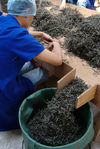
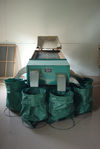
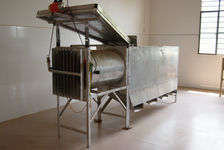
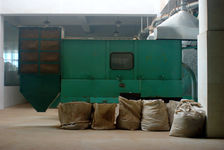
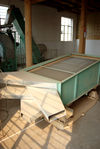
- 1. Manual sorting of grades (Baopuxuan workshop, YiWu)
- 2. Tri mechanical grades (Baopuxuan workshop, YiWu)
- 3. Tri pneumatic degrees (Baopuxuan workshop, YiWu)
- 4. Tri mechanical degrees (factory Haiwan, Aning)
- 5. Tri mechanical degrees (factory Kucong, Pu Er)
The leaves, once sorted from different grades, will be used independently to produce a single grade tea, especially for the finer grades, or they are mixed in specific proportions to harmoniously combine the characters of each grade and to obtain a better homogeneity in the production.
11.Assemblage ( some puerh (Pu Er tea) only )
If today there is a growing market of puerh (Pu Er tea) "rough around the edges", as it is squeezed out of the bag of collecting, especially because it requires less technical knowledge and no, a number of wafers are composed of precise assembly of sheets data. This is particularly true for major productions of the era of state factories, during which the art of assembling the leaves was particularly pushed. More than just a stage, the assembly and the concept of revenue and are critical issues within the culture of puerh.
The blend is mixed in defined proportions of different kinds of leaves before squeezing. Mixtures focus primarily on leaf age, ie their size, but also the season (see the year) of collection types and ages of trees whose leaves come from the gardens in which these leaves are coming, and sometimes their terroir. We can possibly bring the assembly of the French approach puerh (Pu Er tea) with red wine, which while separating out the land uses largely the mixture of grapes, and in this sense differs from many other wine producing countries.
In the case of puerh (Pu Er tea) the original purpose and principal of this assembly is to overcome the random climatic conditions and different stages mentioned above, thereby ensuring a consistent production. The crude Maocha accumulated day after day for months crops are generally not of uniform quality, without pressing his appeal in the sorting and assembly has a good chance of producing disparities between different wafers pressed.
But more assembly keeps the character of a given production from one year to another. This is especially true of the various classic recipes of the old domestic producers such as 7572 or 7542 Menghai Tea Factory, now become classics, reproduced each year "identically" since sometimes more than 40 years. Contrary to what the name suggests recipe, what defines them is indeed the character of the final product, not a given proportion of each type of leaf used, and the composition of this revenue is adjusted annually to take into account the raw material used and weather specific to this year.
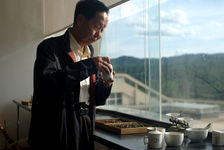
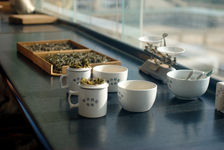
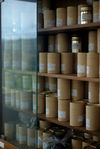
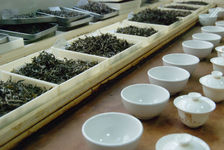
- 1. Zou Bing Liang, grand master of the assembly puerh
- 2. Hall of assemblies Haiwan Tea Industry (Anning)
- 3. Samples of various Mao Cha used in assemblies Haiwan
- 4. Hall of assemblies Chen Sheng (Menghai)
But the notion of the recipe goes much further than the issue of homogeneity. This is when the assembly is done in a quality research to balance the flaws and strengths of each leaf used in the mixture, and their capacity to evolve over time to produce a result greater TODAY ' Today and in years to come. This is undoubtedly the approach most noble assembly, to which the potential of each sheet is weighed and then finely assembled to learn from each other to get the best possible result.
Unlike the mixture of leaves is also widely used by some unscrupulous producers to lower production costs, in "cutting" leaves expensive, eg from soils known or very old trees, with leaves cheaper , eg from young trees growing, cheaper.
12.Compression (gross of puerh)
Puerh tea is usually compressed, particularly to make it more compact, transportable and manipulable by the Maocha puerh (Pu Er tea) being particularly large. The puerh (Pu Er tea) comes in different forms and compressed the most common are the pancake (bing cha) usually 356 or 400 grams, bricks (zhuan cha) typically 250g, bird's nest (tuo cha) typically 100g, but it is also possible to see the puerh (Pu Er tea) compressed disc-shaped, pumpkin, squash or mushroom (jin cha)!
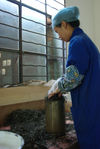
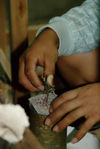
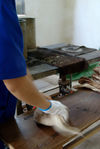
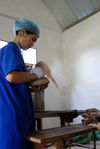
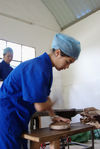
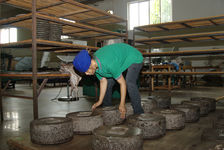
- 1. Compression of a traditional cake puerh (Pu Er tea) (Baopuxuan workshop, YiWu)
- 3. Compression of a traditional cake puerh (Pu Er tea) (workshop Baopuxuan , YiWu)
- 4. Compression of a traditional cake puerh (Pu Er tea) (Baopuxuan workshop, YiWu)
- 6. Compression of a traditional cake puerh (Pu Er tea) (Chen Sheng, Menghai)
Although techniques vary with the form and practices of each producer the basic principle remains the same: the leaves are softened by steaming water before being compressed to the desired shape and then dried. A distinction was molded forms (see the picture [article = 23] Cha Hai Ju Muo, the puerh (Pu Er tea) and molds ... [/item]) forms as the pressed cake.
In general, schematic pressing craft a raw patty puerh (Pu Er tea) occurs as follows:
1-2.A of mao cha certain weight (usually 357 or 400 g) was weighed and then subjected to a current of steam for a short time to rehydrate and soften the leaves.
3.The
mao cha wet and warm is then poured into a cloth bag, it is at this point that the Nei Fei is added at the heart of the leaves.
4. Traditionally the bag is then placed under a stone carved with ten kg
order to further increase the pressure mounts someone standing on the stone and stays there a few seconds 30 seconds
5. The tea is then under the stone about 20 minutes and then remove the stone and leaving the tea bag in the air
Many factories do more press their cakes, or at least most all of their cakes by hand and use a electric or hydraulic press that replaces the traditional heavy stones. Other steps in the press remain largely the same, whether craft or industrial pressing.
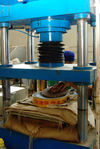
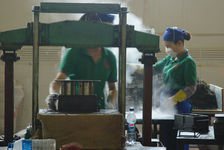
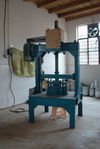
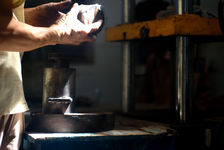
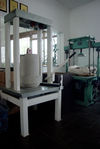
- 1. Mechanical pressing patties (Chen Sheng, Menghai)
- 2. Mechanical pressing bricks (Chen Sheng, Menghai)
- 3. Mechanical press
- 4. Mechanical pressing of discs (Jinuo Cha Shan Chang, Jinuo)
- 5. mechanical press (Liu Shang Da Cha)
The technique has made great strides in recent years and if, in its infancy, the use of mechanical press was heavily criticized by fans (especially because it worked too compressed cakes) some producers are concerned about the quality now able to get through the press, results very close to what can be done by craftsmen. This is particularly the case Jinuo Shan Chang Cha, who after many tests with tools and widely adapted, produced mechanically cakes worthy of craftsmanship. Rarer, other producers as Chen Sheng associate with a double pressing successive mechanical and manual labor in order to take advantage of the contribution of these two techniques.
The pressing of the cake remains in all cases as a crucial step in directly depend on the capacity of puerh (Pu Er tea) to age, especially depending on the greater or less compression of the leaves and their contact with air.
13. Drying
Once compressed, the patties should be dried in order to evaluate the excess water from steam in which the sheets were drenched summers to soften.
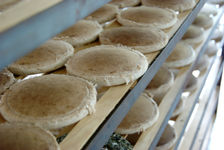
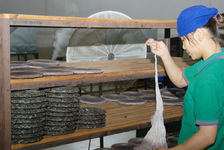
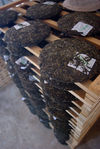
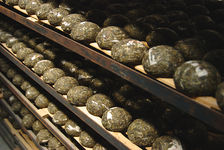
- 1. Cakes just after compression
- 2. Exit wafers their cloth bag (Chen Sheng, Menghai)
- 3. Drying cakes post-compression
- 4. tuos drying after compression
After a first quick-drying, the wafers are removed from a cloth bag and left to dry for a longer period. This drying has traditionally been done simply to air or sunlight when the weather permits and some small farmers continue to practice it that way. However, it is common in larger workshops to place the patties a few days in a ventilated drying room where the temperature is kept consistently high.
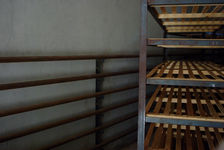
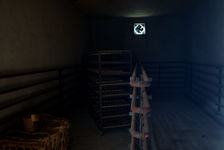
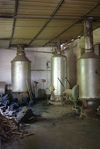
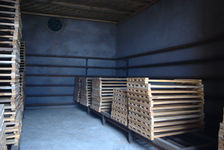
- 1. heated drying room (Baopuxuan, Yi Wu)
- 3. boiler used in particular for allimenter drying rooms
- 4. Drying room heated (Kucong)
14. Packaging
wafers are then packaged by hand, using a square sheet (See [article = 12] repack her cake [/item]). Traditionally used a thin paper and porous, ideally craft and generally based on tree bark which uniqueness of the fibers allows the identification of tea. The wafers are then packaged, always by hand, in stacks of 7 (thong) in three pieces in bamboo leaves (see [article = 43] making of a tong of puerh (Pu Er tea) [/item]). These flip flops are themselves packed by 12 in a basket (jian) also bamboo which is then ready to be shipped to the wholesaler, the seller or the tea house.
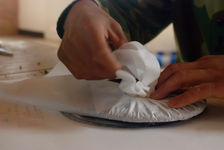
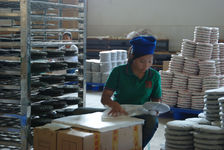
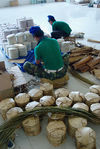
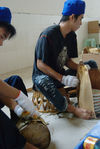
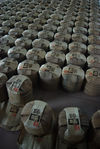
- 1. Packing for a cake puerh (Pu Er tea) (Kucong, Pu Er)
- 2. Packing for a cake puerh (Pu Er tea) (Chen Sheng, Menghai)
- 3. Packing for a tong of puerh (Pu Er tea) (Chen Sheng, Menghai)
- 4. Packing for a tong of puerh (Pu Er tea) (Chen Sheng, Menghai)
- 5. Sandals of puerh (Pu Er tea) ready to be shipped (Baopuxuan, YiWu)
15. Wet storage (for some puerh (Pu Er tea) only )
As is the puerh (Pu Er tea) can be consumed, whether crude or puerh (Pu Er tea) puerh fermented. This is particularly in this form that are commonly consumed in China. A number of consumers, especially in the regions of Hong Kong, Taiwan and Malaysia, however, prefer the flavor of fermented puerh (Pu Er tea) old, which means storage for several years before puerh (Pu Er tea) are consumed.
To accelerate the storage it happens regularly, especially in Hong Kong and Guangzhou (Canton), store the puerh (Pu Er tea) few years in storage conditions and very hot and humid (over 85% humidity). After this storage the puerh (Pu Er tea) will be of optimum quality to be stored a number of years (usually double the period of wet storage) under conditions of dry storage and stable to lose teas unpleasant odors from the wet storage, such as wood odors, dust, dirt or cellar, this is what is called revivification. Such flavors in a trade puerh (Pu Er tea) often come from a wet storage not adequate, poorly controlled, too long, or poor regrowth of tea. The vast majority of tea prior to 90 years in particular have suffered such phases of wet storage and revival.
Contrary to what the term implies storage, wet storage of tea as traditionally practiced in Hong Kong is not in the conservation of tea in the long term but to a transformation phase, voluntary, conscious and artificial in its approach approximates well the fermentation of artificial puerh (Pu Er tea) precompression.
Such wet storage quality, as some still practice in Hong Kong is an art in itself, requires great skill, great attention to rigor and time, and some became master in the art of carving and the character of puerh (Pu Er tea) after compression. In most cases however, the sloppy and wet storage is regarded simply as an easy way to accelerate aging of puerh (Pu Er tea) puerh and results in poor quality flavors largely marked by moisture, which explains the bad reputation that often wet storage.
16. Storage /aging puerh (Pu Er tea) ( some puerh (Pu Er tea) only )
As stated previously the puerh (Pu Er tea) can be consumed as it is generated, whether crude or puerh (Pu Er tea) puerh fermented. The young especially puerh (Pu Er tea) crude is rich in aromatic complexity and a very valuable and is deeply influenced by the soil which it comes. The puerh (Pu Er tea) however, are often stored a number of years before being sold, and we thus find in the market for puerh (Pu Er tea) older than a year to several decades. Similarly many young fans buy cakes for the store at home for a few years or decades.
If the majority of teas will quickly lose their flavor to become insipid, the puerh (Pu Er tea) does have the double feature not only keep its intensity gradually as the years go by but mostly gradually transformed over time. A cake is well puerh (Pu Er tea) something alive and changing from year to year. If the fermented puerh (Pu Er tea) will only be refined in the manner of red wine, raw puerh (Pu Er tea) undergo a transformation when his more important post called fermentation and after a number of years will approach an puerh (Pu Er tea) fermented. Initially the green leaves of a crude puerh (Pu Er tea) old are gradually dark brown, burgundy brown produce a liquor while their taste is round, soft and warm. To grow old in this way, in contact with air and moisture, the puerh (Pu Er tea) material is packaged in breathable, porous paper for cakes, bamboo leaves for flip flops, wide mesh of bamboo for jian, and stored in a place free from odor, ventilated and protected from direct sunlight. This storage can be either depending on the case made by the wholesaler or retailer or by the consumer (home storage).
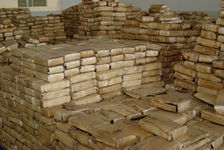
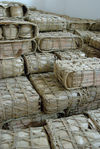
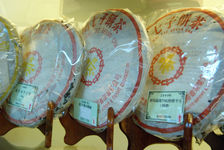
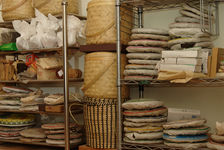
- 1. Stock (dry) of puerh
- 3. Etallage wafer in an old tea shop in Hong Kong
- 4. Storage puerh (Pu Er tea) staff for its aging
Whatever the case, the aging of puerh (Pu Er tea) must be done carefully. This is a complex area where many factors are involved, starting with the heat and humidity in which teas will be stored. Storage wetter accelerate notably the phenomenon of post-fermentation, but will also have a particular influence on the aroma of tea in front of a slower and dry storage. Unlike the storage of wine or cigars, there is not a standard given that references about the ideal conditions of storage, several schools for the storage of live puerh (Pu Er tea) and result in teas taste very different characters.
Beyond cultural preferences, which include the young puerh (Pu Er tea) is consumed in mainland China, particularly in Yunnan, while it is preferred to old Hong Kong, Taiwan and Malaysia, the choice of a young tea, an old tea or two, and the choice of storage conditions of these tea are essentially matters of taste and affinity for a particular type of puerh. In the sense that the puerh (Pu Er tea) gets better with age is a bias and it is probably best to estimate the puerh (Pu Er tea) changes over time, and choosing a particular vintage or what time start a cakes its collection according to his personal attraction.
Hopefully this article has interested and, perhaps, you will see a different look next cake you buverez I wish you a good week!
Olive

